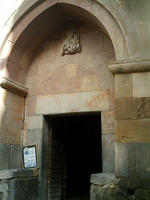You are in: Middle East -> Iran -> Armenian Monastic En... , and traditional search or Image Gallery will yield results of this site only
Armenian Monastic Ensembles in Iran
| Site number: | 1262 |
|
| Type of site: | Cultural | |
| Date: | 7th century | |
| Date of Inscription: | 2008 | |
| Location: | Middle East, Iran (Islamic Republic of), West Azarbaijan Province | |
Up to 75 images are shown here. Click on each for more details or on Image Gallery for more images.
| Description: | The Armenian Monastic Ensembles located in north-western Iran, are composed of three monastic ensembles of the Armenian Christian faith: St Thaddeus and St Stepanos and the Chapel of Dzordzor; the oldest of these being St Thaddeus which dates back to the 7th century. These monuments exemplify the Armenian architectural and decorative traditions that hold an outstanding universal value. The site is a significant testimony to regional cultural exchanges, particularly involving the Byzantine, Orthodox and Persian. The monasteries composed a major centre for the spreading of Armenian culture throughout the region, having been positioned on the south-eastern border of this cultural space’s main area. They constitute the last of this culture’s remains within this region; they have managed to preserve an adequate state of integrity and authenticity. As spaces of pilgrimage, the monastic ensembles have bared witness to Armenian religious traditions throughout the centuries. --WHMNet paraphrase from the description at WHC Site, where additional information is available. | |
| In the West Azarbaijan Province, Islam (Sunni and Shiite) is the majority religion. However, there is also a large Christian minority, Assyrians who have historically lived on the west shore of Lake Urmia, as well as Armenians who are scattered throughout the province. Notably, the city of Maku in northern West Azarbaijan was the only city in Iran (before World War II) where Christians comprised the majority. Before World War I, Christian Armenians and Assyrians compromised a significant minority in Urmia, but that during the Ottoman and Russian Wars (during WWI) many left the region.St. Thaddeus Cathedral is located on the outskirts of Chaldoran, near the village of Qara-Kelissa. Besides being a religious site with a particular significance among Iranian Christians, particularly Armenians, this large church (monastery) is also a rare and valuable monument in architectural and artistic terms.St. Thaddeus, also known as Jude Thaddeus or Jude Labbeus, was one of the apostles of Jesus Christ who traveled to Armenia, where he was later killed and upon whose grave the locals erected a small chapel in AD 301. The cathedral is known as Qara-kelissa ('Black church' in Turkish) to the locals, owing to the appearance of its western section. In 1329, the church was reconstructed in its present form after an earthquake destroyed the structure in 1319.n all, thirty-one churches are registered by the Cultural Heritage Organization of Iran in the province. Many of these are historical landmarks and unusually rich in heritage. Some of the more famous ones are listed as follows: Qara Kelissa (The Black Church), Armenian, Chaldoran, early Christianity. Kelisa Naneh Maryam (Church of Mother Mary), Assyrians, Urmia, Sassanid era.Kelisa Hazrat Maryam (Church of Mary), Assyrian, Urmia, late Sassanid period.Kelisa Surep Serkis, Khoy, 4th century AD. Kelisa Haftvan, Salmas, Armenian, 13th century. Kelisa Golpashan, Urmia, rebuilt in 1905. Kelisa Martoma (Church of Thomas), believed by local Armenians to be the first church in Iran founded by St. Thomas himself. Kelisa Qarabagh, Armenian, Ilkhanid period. Kelisa Marserkis, Assyrians, Urmia, Sassanid era. Kelisa Petrosoplos (Church of Paul and Peter), Urmia, believed built by Bukhtishu. Kelisa Golan, Assyrians, 5th century. Kelisa Mardanial, outside Urmia, Sassanid era, destroyed in World War I, rebuilt. Kelisa Vank Khosrow-abad, near Salmas, Assyrians, built by Khosrau II of Persia. The Holy Cross of Jerusalem was kept here for a while. Kelisa Zurzur, Chaldoran, built in AD 1315. In 2008, UNESCO selected a group of these religious structures as part of the Armenian Monastic Ensembles in Iran World Heritage Site. --Wikipedia. Text is available under the Creative Commons Attribution-ShareAlike License. | ||
| Source: | http://whc.unesco.org/en/list/1262 | |
| Reference: | 1. UNESCO World Heritage Center, Site Page. | |

















